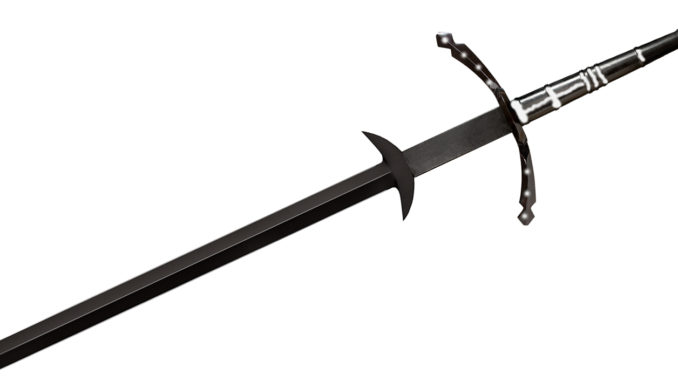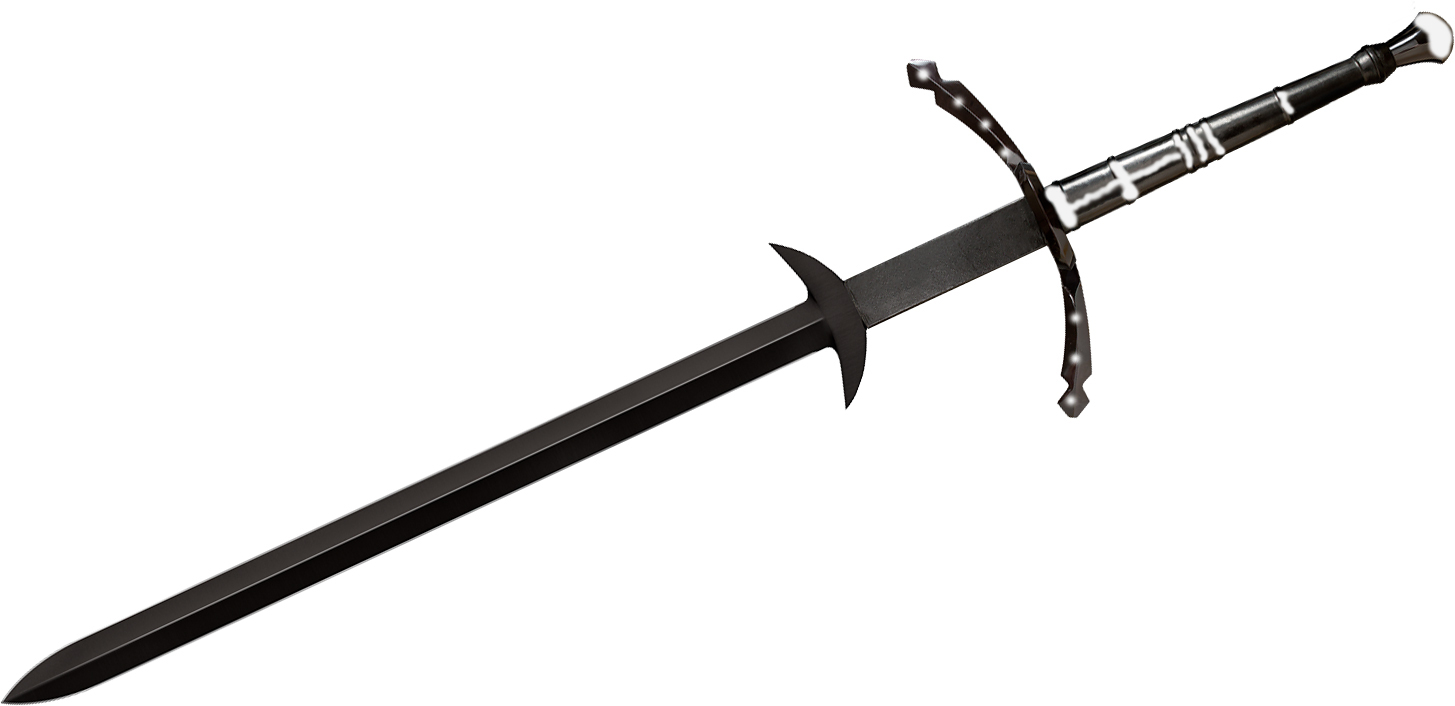
This week we finish up our look at the Dead Steel Weapons with the game stats for the greatsword Corpsebane and finish up with some campaign seeds featuring these legendary magical items. You can see Part 1, Part 2, and Part 3 here respectively.
Corpsebane
Weapon (greatsword), legendary (requires attunement by a creature of non-evil alignment)
An unassuming brown leather scabbard holds a blade of black steel almost 5 feet in length. What appears to be ivory is inlaid into the hilt and cross guard, forming runes connecting the blade to the gods of death and the underworld. One closer inspection, one might find the ivory is actually polished bone of humanoid origin.
You gain a +3 to attacks and damage rolls with this weapon. This weapon deals an extra 2d6 points of damage to undead creatures. Additionally, creatures, either living or dead that are slain by Corpsebane are unable to be raised by either the Animate Dead or Create Undead spells. Such attempts automatically fail. This does not prevent other resurrection spells or attempts from working. Additionally, while attuned to Corpsebane, its wielder has resistance to necrotic damage and gains advantage on saving throws made against spells from the necromancy school and to any saving throws they are forced to make by undead creatures. Once per day the wielder can benefit from a single casting of heal or greater restoration cast from the weapon. Once either of these spells has been cast, this ability cannot be used again until dawn the next day.
Sentience. Corpsebane is a sentient weapon of neutral good alignment. It has an Intelligence of 15, a Wisdom of 13, and a Charisma of 16. It has normal hearing and vision out to 60 feet and can sense the presence (but not the type) of undead creatures out to 120 feet.
The weapon can speak, read, and understand Common, and can communicate with its wielder telepathically. It is the most taciturn of the Dead Steel Weapons, but will offer advice and opinions if asked or otherwise prompted.
Personality. Of all the Dead Steel Weapons, Corpsebane is arguably the most pragmatic about its role. It knows that it is designed to bring true death to the undead. But while filling that function, it is also responsible for bringing that same true death to the living so that they may not be used by the forces of undeath later. Conflict occurs when the wielder is not taking action to destroy the undead or their living forces.
Using the Dead Steel Weapons
Arguably the easiest way to include these five weapons into your game is to use them as macguffins to stop a BBEUG (Big Bad Evil Undead Guy) from taking over the world, culminating in a classic showdown of good versus evil as the heroes bring all of their powers to bear to stop the undead apocalypse from covering the world in the darkness of undeath. But I know you can think of more clever ways to use them than that. But just in case you need a little bit of help, I’ve included three quick campaign seeds using the Dead Steel Weapons as a campaign focus.
Let No Man Put Asunder or Else They Be Put Under
There will always be those that stand against the world of the living – whether it’s the undead themselves or creatures in service (or thrall) to the undead, that dark power is always going to be present. The Dead Steel Weapons are a known quantity within the realm, and have been a vicious thorn in the side of those powers of undeath for a long time. Just as there are those adventurers that seek the weapons to defend the realms of the living, there are those that seek them so they can be destroyed. This campaign seed sees the heroes racing against the forces of darkness to find the Dead Steel Weapons first. If they don’t, they are most likely consigning the weapons to oblivion and robbing the realms of the living of powerful weapons in the future. If only those darned magic items didn’t like to hide in dungeons so much!
Two Minutes to Midnight
What happens when intelligent magical items think they know better than you? The Dead Steel Weapons are a powerful force of good within the realm. Of that, there is no doubt. They have stopped more undead threats and saved the realm more times than have been recorded in the history books. That can’t be a bad thing, can it? Their purpose is to save the realm of the living, after all. But they know that nothing in existence is permanent. The undead can only be held off for so long before even their might fails. They have stopped so many threats since their creation, and it appears that they will face many more before their time is done. And so, over the years they have come to the sad realization that the only way that they win over the forces of the undead is if there are no living for them to threaten. They wish to be taken to the Anvil of Icarros where they tell their wielders, they will be able to uncover the secret of stopping the undead forever. Once there, they join their powers together and begin the process of unmaking the world. Now the heroes are faced with stopping a cataclysm that they helped to unleash, with the Dead Steel Weapons fighting them every step of the way. The artifacts are convinced that this is the only way to prevent another ruler like Kharos from taking over after they are gone and will use all of their powers to fight back against the heroes.
Lord Kharos’s Final Revenge
The Dead Steel Weapons are one of mankind’s best chances of stopping the threat of another creature like Lord Kharos from taking power again. But the fact that these weapons were created from the very thing they seek to stop in the future worried several of the clerics that oversaw their construction. How could something so evil be completely transformed into artifacts of pure good? What if something of the Death Knight survived within the weapons? The truth is far direr than they imagined. Fractions of Kharos’s spirit reside within each of the artifacts, but the magic used to create them keeps them largely inert and powerless. At least individually. Kharos uses the weapons’ natural desire to be gathered together to bring those fractured pieces of his spirit into proximity with each other, where they can join with each other and grow more powerful. From there he subtly attempts to bring the wielders of the Dead Steel Weapons into conflict with the artifacts, hoping to transfer his spirit from the weapon into a living host. From there he can start to corrupt the wielders and set the stage for his eventual return to the world. This plot culminates in the heroes unwittingly taking part in the destruction of the Dead Steel Weapons in the ruins beneath Kharos’s ancient fortress in the former kingdom of Arceel, where they were first brought into this world. The unmaking of these weapons frees the remainder of his power, and from there the corruption of his hosts will be complete, allowing him to be reborn in a new form.

